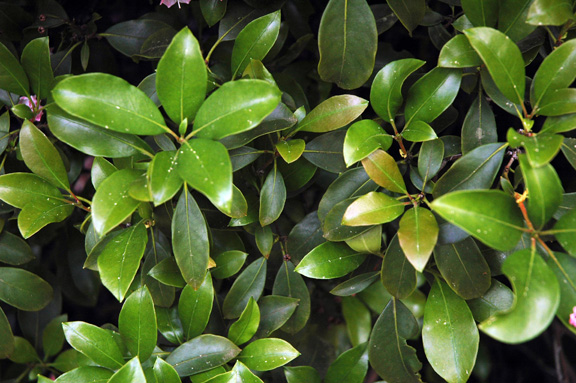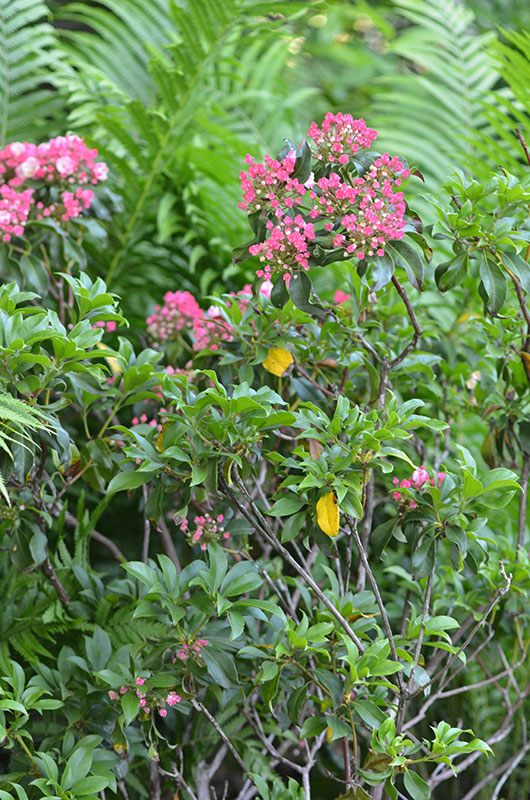
Woody > Kalmia > Kalmia latifolia > Kalmia latifolia
Kalmia latifolia
Mountain-laurel
Origin: Eastern North America.
Mike's
Opinion


"
Mountain-laurel is a striking broad-leaf evergreen with showy flowers. It makes a beautiful shady border or massing with year-round interest. It is good for naturalizing areas because it prevents soil erosion and attracts wildlife such as birds and deer. A note of caution: mountain-laurel is highly toxic and if any part of the plant is ingested it can be fatal so it should never be planted in areas where children frequent.
Michael Pascoe, NDP., ODH., CLT., MSc. (Plant Conservation)
"
| Family |
| Ericaceae |
| Genus |
| Kalmia |
| Species |
| latifolia |
| Category |
| Woody |
| Type |
| Shrub (evergreen) |
| Pronunciation |
| USDA Hardiness Zone |
| 4–9 |
| Canadian Hardiness Zone |
| 5–10 |
| Temperature (°C) |
| -30 |
| Temperature (°F) |
| -22 |
| Height |
| 1–4.5 m |
| Spread |
| 1–4.5 m |
Photographs
Description and Growing Information
Flowering Period
| General Description |
| Mountain-laurel is an evergreen shrub with a rounded form. The leaves are elliptical shaped with a dark green colour. The leaves have a glossy sheen to them. Showy, pink to white flower clusters at the shoot tips are the most noticeable feature of this plant. |
| Landscape |
| Mountain-laurel is an excellent ornamental shrub for shady borders and massing. Masses of mountain-laurel look lovely in summer because of its showy flowers. Mountain-laurel can form dense thickets known as ‘laurel hells’, which make it useful for preventing runoff and soil erosion. It is sometimes used to naturalize landscapes because it provides nesting habitat for birds. If an area is frequented by children mountain-laurel should not be used because ingestion of any plant part can be fatal. |
| Cultivation |
| Mountain-laurel is prone to root rot so it must be planted in well drained soils to prevent moisture buildup. It requires rich, acidic soils and prefers partial shade but it can tolerate full sun. Growth is best when root zone is kept cool. |
| Shape |
| Mountain-laurel has a rounded shape. It is generally symmetrical and dense in youth and as it ages it becomes more open and straggly. |
| Growth |
| Medium |
| ID Characteristic |
| Mountain-laurel has elliptical-shaped green leaves with entire margins in an alternate leaf arrangement. Flowers have five petals that are fused into a pentagon-like saucer. Fruit are dehiscent seed capsules that occur in upright clusters. |
| Pests |
| A number of pests and diseases can affect mountain-laurel: leaf spot (Phylosticta kalmicola), shoestring root rot (Carmillaria mellea), blight, flower blight, scale, whitefly, black vine weevil, azalea stem borer, and rhododendron borer. |
| Habitat |
| Mountain-laurel is an understory plant that is found in many plant communities. It is typically found in rocky woods and clearings, and at wood edges where light filters through. Sites must have well drained, acidic soils. The largest wild specimens are found in the Appalachian Mountains. |
| Bark/Stem Description |
| Bark is thin and reddish brown. It has a tendency to shred which creates furrows and ridges. Trunks become gnarled and twisted with age. |
| Flower/Leaf Bud Description |
| Buds are small (about 5 mm across), lateral buds are hidden behind petioles and are almost imbedded in the stem, and terminal buds bearing elongated inflorescence are not visible until March. |
| Leaf Description |
| Leaves are 5–12 cm long and 1.5–5 cm wide. They have an elliptical shape with entire margins. Leaves generally have an alternate arrangement but some maybe whorled. Leaf colour is dark green to yellow-green depending on light conditions (yellow-green in full sun, darker green in shade). Leaves are leathery with a glossy appearance. |
| Flower Description |
| Flowers are 2–3 cm across and range in colour from white to pink. The flowers have a saucer-like shape and are grouped in clusters around shoot tips. Each flower has 5 fused petals and 10 stamens. These flowers have a unique pollination method: as the flower matures anthers are under tension and they spring forward when an insect touches it, which effectively coats the insect in pollen. |
| Fruit Description |
| Fruit are 5 mm across, brown, dehiscent seed capsules with 5 valves that persist in winter. |
| Colour Description |
| Flowers have showy colours ranging from white to pink, leaves are a dark glossy green, and bark is grey to reddish brown. |
| Texture Description |
| Medium. |
| Notable Specimens |
| Mountain-laurel specimens are located at Algonquin College Ottawa, Ontario, Canada and at the University of British Columbia botanical garden in Vancouver, British Columbia, Canada. |
| Propagation |
| Mountain-laurel can be propagated via cuttings or seeds. Cuttings should be taken from the current year’s growth as soon as it ripens. Two wounds should be made on the opposites sides of the cutting’s base to allow for root emergence (cuts are 2.5–3.8 cm long). Rooting takes 4–6 months so cuttings must be kept in an environment that prevents nutrient leaching such as a polyethylene chamber. Hormone treatments that enhance root formation include IBA and NAA. If propagating from seed, seed capsules should be collected in autumn and allowed to dehisce. Then collect seeds and sow in a pot. Germination is enhanced by stratification so placing sown seeds in a cold frame for the winter will enhance success. |
References
League, Kevin. “Kalmia latifolia”. Fire Effects Information System. U.S. Department of Agriculture, Forest Service, Rocky Mountain Research Station, Fire Sciences Laboratory. Mar 3. 2012. 2005.

